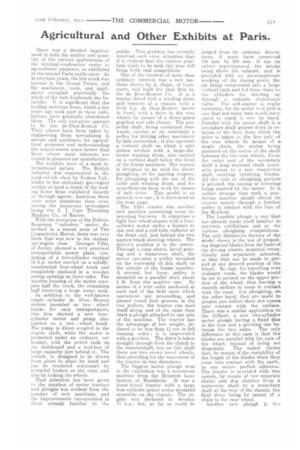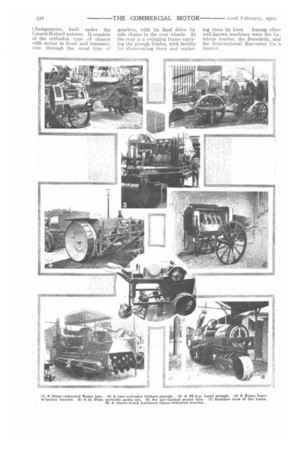Agricultural and Other Exhibits at Paris.
Page 23

Page 24

If you've noticed an error in this article please click here to report it so we can fix it.
There was a decided improvement in both the quality and quantity of the various applications of the internal-combustion motor to agricultural purposes, as exhibited at the annual Paris cattle show. As in previous years, the live stock was housed in the Grand Palais, and the machinery, tools, and appliances occupied practically the whole of the vast Esplanade des Invalides. It is significant that the leading motorcar firms, which a few years ago took part in these exhibitions, have gradually abandoned them. The only exception appears to be the de-Dion-Bouton Co. Their places have been taken by engineering firms specializing in motors and machinery for agricultural purposes and understanding the requirements much better than firms whose main interests are vested in pleasure-car manufacture.
The exhibits were of a most in
ternational nature. The British industry was represented in the road-vehicle class by Fodens Ltd., whilst in the stationary gas-engine section at least a dozen of the. leading home firms exhibited directly or through agents. American firms were more numerous than ever, among the important newcomers being the J. IS Case Threshing Machine Co., of Racine.
With the exception of the DuboisRousseau " valveless " motor, described in a recent issue of THE COMMERCIAL Moron, there was very little that was new in the station
ary-engine class. Georges Filtz, of Juvisy, showed a very practical transportable power plant, consisting of a two-cylinder vertical 12 h.p. motor carried on a solidlyconstructed four-wheel truck and completely enclosed in a wooden easing opening on three sides. The wooden housing of the motor occupies half the truck, the remaining half receiving a large water tank.
In addition to the well-known single cylinder de Dion Bout on motors mounted on two wheel trucks for easy transportation, this firm showed a new fourcylinder motor and pump also carried on a two wheel truck. The pump is direct coupled to the engine shaft, while the motor is protected under an ordinary ear bonnet, with the petrol tank on the dashboard and a tool-box of large capacity just behind it. The vehicle is designed to be drawn from place to place by hand and can be rendered stationary by powerful brakes on the rims, and also by locking the wheels.
That attention has been given to the question of motor tractors and ploughs was evident from the number of new machines, and the improvements incorporated in those already familiar to the public. This problem has recently received such close attention that. it is evident that the various practical trials to be held this year will bring forth real competition.
One of the tractors of more than ordinary interest was a new machine shown by A. Bajae, of Linncourt, and built for that firm by the de Bion-Bouton Co. It is a tractor fitted with a winding drum and consists of a chassis with a 30-ee hp. de Dion-Bouton motor in front, with a drive to the rear wheels by means of a three-speed gearbox and side chains. The propeller shaft, being continued rearwards, carries at its extremity a pulley for driving other machinery by belt. connection ; it also operates a vertical shaft on which a spur pinion meshes with a large-diameter winding drum, also carried on a vertical shaft below the level of the frame members. The tractor is designed to be used for direct ploughing, or for hauling reapers, for ploughing with the use of the cable and winding drum, and for miscellaneous farm work by means of belt drive. This model is an entirely new one ; it is illustrated on the next page.
The Filtz tractor was another new machine possessing some interesting features. It comprises a light four-wheel chassis with a fourcylinder motor under a. bonnet at one end and a coil-tube radiator atthe front end, just. behind the two narrow-track steering wheels. The driver's position is in the centre. Through a cone clutch, bevel gearing and a transverse shaft, the motor operates a pulley mounted on the extremity of this shaft on the outside of the frame member. A second, but loose, pulley is mounted on a parallel shaft about 2 ft.. front the positive one. By means of a wire cable. anchored at each end of the field upon which operations are proceeding, and passed round four grooves in the Iwo pulleys, the tractor can haul itself along, and at the. same time draw a plough attached to one side of the machine. The tractor has the advantage of low weight, declared to be less than 11ton in full running order ; it is unprovided with a gearbox. The drive is taken straight through from the clutch to the countershaft, but on this shaft there are two crown bevel wheels, thus providing for the movement of the tractor in two directions.
The biggest motor plough seen in the exhibition was a. monstrous machine from the Heinrich Lanz factory at Mannheim. It was a. three-wheel tractor with a largefour-cylinder petrol motor mounted crosswise on the chassis. The engine was declared to develop 70 h.p., but, so far as could be
judged from its external dimensions, it must have measured 130 mm. by 200 min. It has its valves superimposed, the intake being above the exhaust, and is provided with an air-compressor working off the timing gears, the air being compressed into a large vertical tank and fed from there to the cylinders for starting up through a suitable distributor valve. The self-starter is really necessary, for the motor is of such se size, that not many men would have cared to crank it over by hand. Parallel with the motor shaft is as secondary shaft geared down in relation to the first, from which the drive is taken to the live axle of the rear wheels by means of a. single chain, the pinion being mounted on the centre of the shaft between the two rear wheels. From the outer end of the secondary shaft a long enclosed chain transmits power to a rear transverse shaft carrying revolving blades_ All the rear or ploughing portion is pivoted, the raising or lowering being assured by the motor. It is rather strange that such a ponderous machine should obtain its. reverse, merely through a friction pulley in contact with the face of the flywheel, The Landrin plough is one that has already made it-self familiar in previous exhibitions and at thevarious ploughing competitions.. The only distinctive feature of the model shown is the use of projecting diagonal blades from the faces of: the driving wheels, mounted eccentrically and separately actuated,, so that they can be made to project at any desired position of the wheel. So that, for travelling overordinary roads, the blades would. be set to project on the upper portion of the wheel, thus leaving assmooth surface to come in contact with the road. For ploughing, on the other hand, they are made to projectjust before their slot comes into contact with the surface. There was a similar application to. the Gilbert, a new two-cylinder motor plough having a fixed disc in the rear and a pivoting one between the two axles. The only difference in this case is that the blades are parallel with the axis of' the wheel, instead of being set. diagonally. The maker claims that, by reason of the variability of the length of the blades when they come into contact with the earth, he can secure perfect adhesion.. The tractor is provided with two speeds, by means of two separate chains and dog clutches from a transverse shaft. to a secondary shaft at the rear of the chassis, the final drive being by means of a. chain to the rear wheel.
Another new plough is this
ehampenoise, built under the Linard-Hubert patents. It consists of the orthodox type of chassis with motor in front and transmission through the usual type of gearbox with its final drive by side chains to the rear wheels. At the rear is a swinging frame carrying the plough blades, with facility for .dismounting them and replac ing them by hoes. Among other well-known machines were the Le febvre tractor, the Benedetti, and the International Harvester Co.'s tractor.




























